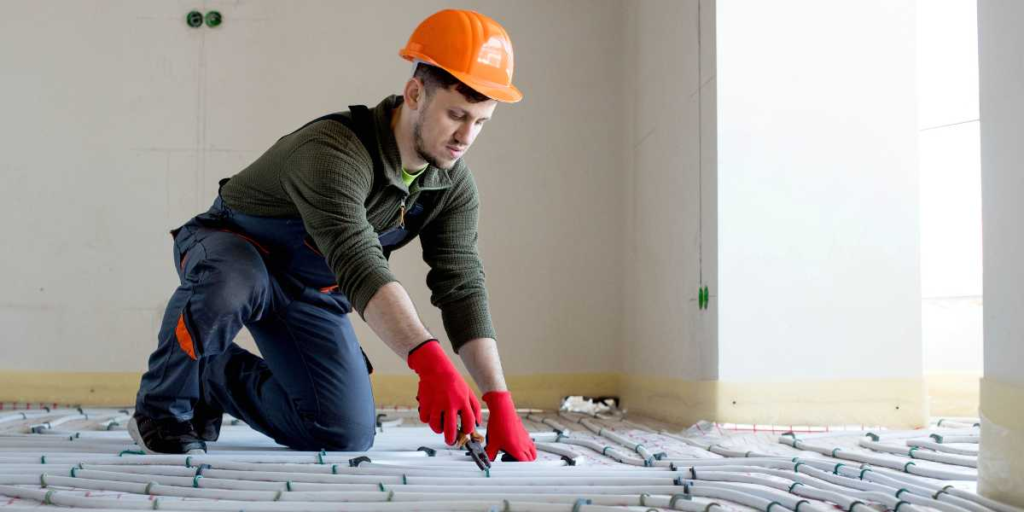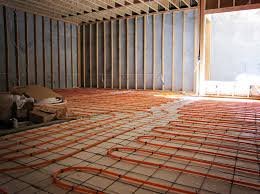Waking up on a chilly morning and stepping onto icy floors can be a rude awakening. Even with central heating, floors often remain cold, especially in bathrooms, kitchens, and basements. But there’s a solution that not only eliminates cold floors but also transforms your entire home’s comfort: radiant floor heating.
This luxurious yet practical upgrade is becoming a favorite among homeowners looking to elevate their living experience. But beyond the cozy toes, radiant floor heating offers a range of benefits that make it totally worth it. Whether you’re building new or renovating, here’s why it’s time to seriously consider warming up from the ground up.

What Is Radiant Floor Heating?
Radiant floor heating systems deliver warmth directly through the floor, creating an even, consistent heat that rises naturally. There are two main types:
- Hydronic Systems: Use heated water circulated through tubing beneath the floor. Best for whole-home heating and energy efficiency.
- Electric Systems: Use electric cables or mats beneath the floor. Ideal for smaller spaces or individual rooms.
Both systems are installed beneath the flooring—whether tile, stone, laminate, or engineered wood—and provide silent, invisible heating that transforms the feel of your space.
Benefits That Go Beyond Warm Feet
1. Consistent Comfort
Unlike forced-air systems that cycle on and off, causing temperature fluctuations, radiant floor heating provides steady, even warmth throughout the room. No more hot spots or cold corners—just consistent comfort. Heat radiates from the floor up, warming everything in its path and creating a more natural and pleasant environment.
2. Energy Efficiency
Radiant systems operate at lower temperatures than traditional heating systems, making them more energy-efficient. Hydronic systems, in particular, can significantly reduce heating bills over time, especially in colder climates. The efficient distribution of heat means less energy is wasted, and you can often set your thermostat lower while maintaining the same level of comfort.
3. Improved Air Quality
Because radiant systems don’t blow air, they don’t circulate dust, allergens, or pet dander, making them a healthier option for those with respiratory sensitivities or allergies. This can be especially beneficial in homes with young children or elderly family members who are more sensitive to indoor air quality.
4. Space-Saving Design
No vents, radiators, or baseboard heaters means more usable space and design flexibility. You can arrange furniture freely without worrying about blocking heat sources. This minimalist approach to heating enhances the overall aesthetic of your rooms, contributing to a clean, uncluttered look.
5. Quiet Operation
No more clunky furnaces or noisy vents. Radiant floor heating is completely silent, adding to the peaceful ambiance of your home. This is particularly appreciated in bedrooms or meditation spaces, where noise can disrupt relaxation and sleep.
6. Zoned Heating Options
Radiant heating allows for individual zoning, meaning you can control the temperature of each room separately. This is perfect for households with varying comfort preferences or rooms that are used at different times of the day. It also helps maximize energy savings by only heating the spaces in use.
Best Places to Install Radiant Floor Heating
While radiant heating can be installed throughout the home, certain areas benefit most:
- Bathrooms: Step onto warm tiles every morning—pure bliss.
- Kitchens: Comfort while cooking and entertaining, especially on tile or stone floors.
- Basements: Combat naturally cold concrete floors with consistent heat.
- Bedrooms: Cozy toes make for better sleep and a luxurious retreat.
- Living Rooms: Ideal for large open spaces, offering seamless warmth.
For new builds, whole-home systems are easily integrated. In renovations, electric systems offer a flexible option for targeted areas, making it possible to retrofit without major demolition.
Installation: What to Expect
Installing radiant floor heating typically involves:
- Assessment: Evaluating your home’s layout and heating needs.
- Preparation: Removing existing flooring (if retrofitting) and ensuring a level subfloor.
- Installation: Laying tubing or mats, followed by new flooring material.
- Connection: Linking to a thermostat and power or boiler system.
Professional installation ensures safety, efficiency, and long-term performance. While the upfront cost can be higher, the payoff in comfort and savings is undeniable. Many homeowners find that the added comfort and efficiency justify the investment.
Cost Considerations
- Electric Systems: Lower upfront cost, higher operating cost. Best for small areas like bathrooms.
- Hydronic Systems: Higher upfront cost, lower long-term cost. Ideal for larger areas or whole-home heating.
Incentives and rebates for energy-efficient systems can help offset installation costs. Additionally, many homeowners find that radiant heating can increase home value, making it an appealing feature for future buyers.
Common Myths About Radiant Floor Heating
“It Only Works with Tile Floors”
While tile and stone are excellent conductors of heat, radiant systems also work with laminate, engineered wood, and even some carpet types. Advances in technology have expanded compatibility, making it accessible for almost any room.
“It’s Too Expensive to Install”
While installation costs can be higher than traditional heating systems, the long-term energy savings, increased comfort, and added home value often outweigh the initial investment.
“It Takes Too Long to Heat Up”
Radiant systems are designed for steady, maintained warmth, rather than quick bursts of heat. When set properly, they maintain consistent comfort without noticeable lag.

Radiant Heating and Sustainability
Energy efficiency isn’t just about savings—it’s also about reducing environmental impact. Radiant systems, especially hydronic, use less energy to achieve the same comfort levels as forced-air systems. When paired with sustainable energy sources, like solar or geothermal, radiant heating can be part of a green home solution.
Real-Life Comfort: Testimonials
Many homeowners report that radiant floor heating is their favorite home upgrade. They love the feel of warm floors in winter, the absence of drafts, and the quiet, efficient operation. It turns daily routines into small luxuries and makes cold seasons far more enjoyable.
Final Thoughts: A Worthwhile Upgrade
Radiant floor heating isn’t just a luxury—it’s a lifestyle upgrade. It brings warmth, comfort, and efficiency to your daily routine. No more cold feet, no more noisy heaters, just consistent, cozy warmth right where you want it.
Whether you’re planning a remodel or building from scratch, radiant heating is one investment that delivers comfort you can feel every single day. It transforms your home into a sanctuary of warmth and peace, making winter days more enjoyable and your living space more inviting.
So go ahead, treat your feet—and your whole home—to the warmth they deserve. Radiant floor heating isn’t just worth it; it’s a decision you’ll appreciate every step of the way.







